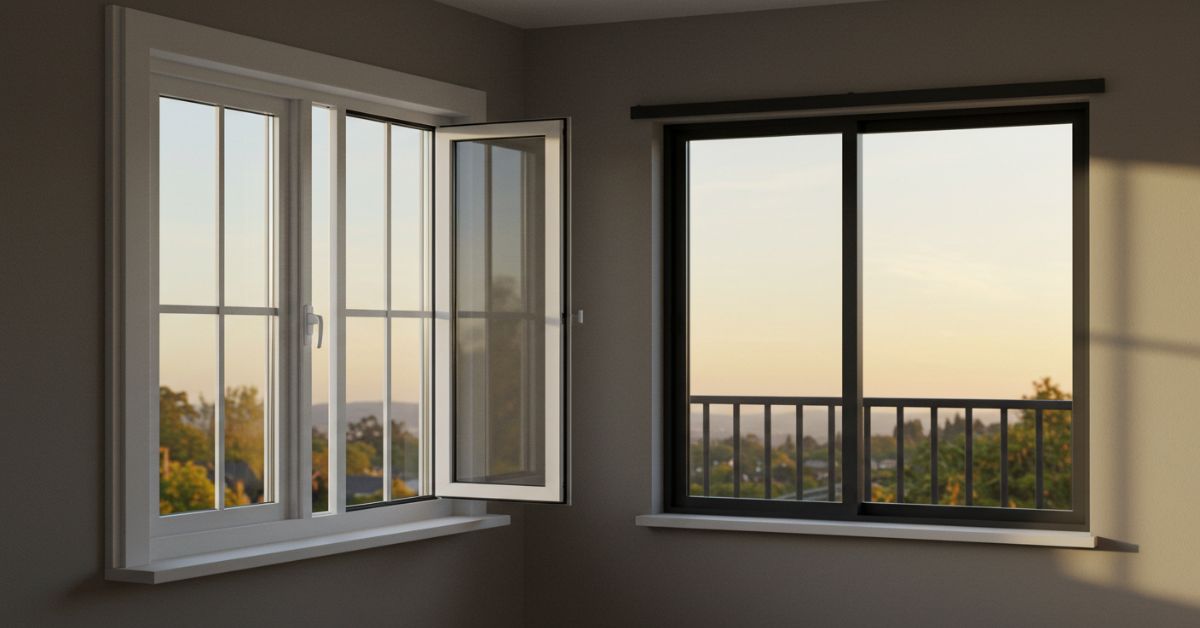When selecting windows for a residential or commercial building, functionality, appearance, and energy efficiency play critical roles. Two of the most popular window styles in modern construction are casement windows and sliding windows. Both offer distinct advantages and potential drawbacks, depending on your architectural needs, space constraints, and ventilation requirements.
Whether you’re working on a commercial project or designing your dream home, choosing the right type of window matters. Industry professionals often look to specialized manufacturers like aprodoor. to source high-quality aluminum windows tailored to a project’s performance and aesthetic requirements.
In this article, we’ll break down the differences between casement and sliding windows, helping you make a smart, informed choice.
Contents
- 1 1. What Are Casement Windows?
- 2 2. What Are Sliding Windows?
- 3 3. Aesthetic Comparison
- 4 4. Energy Efficiency: Which Performs Better?
- 5 5. Ventilation Capabilities
- 6 6. Cleaning and Maintenance
- 7 7. Cost Considerations
- 8 8. Security and Safety
- 9 9. Space and Clearance Needs
- 10 10. Which Window Is Best for Your Project?
- 11 Final Thoughts
1. What Are Casement Windows?
Casement windows are attached to their frames by hinges at the side. They open outward like a door, typically using a crank mechanism.
Key Characteristics:
. Hinged at the side
. Opens outward (left or right)
. Crank-operated or manually pushed
. Provides full window ventilation
Benefits of Casement Windows:
. Maximum Ventilation: Opens fully to catch side breezes.
. Excellent Sealing: The sash presses tightly against the frame when closed, offering better energy efficiency.
. Clear Views: No vertical dividers obstruct the view.
. Security: Harder to pry open from the outside, especially with multi-point locks.
Ideal Use Cases:
. Bedrooms, kitchens, or areas where full airflow is needed
. Commercial buildings where tight seals are critical for insulation
. Narrow window openings needing top-to-bottom ventilation
2. What Are Sliding Windows?
Sliding windows move horizontally along a track and typically consist of two or more sashes, with at least one being operable.
Key Characteristics:
. Slides open from side to side
. Fixed and operable panels
. Simple track mechanism
. Often larger in width than height
Benefits of Sliding Windows:
. Ease of Use: No cranks or levers—just slide to open.
. Space-Saving Design: Doesn’t protrude outward or inward, making it ideal for tight spaces.
. Wide View: Typically designed with larger glass areas for panoramic visibility.
. Low Maintenance: Fewer mechanical parts mean fewer repair needs.
Ideal Use Cases:
. Living rooms, hallways, or wide openings
. Apartment complexes with limited exterior clearance
. Commercial buildings with horizontal design emphasis
3. Aesthetic Comparison
Both window styles can enhance building aesthetics, but in different ways.
Casement Windows:
. More traditional or European in appearance
. Clean, vertical lines suit classic or cottage-style homes
. Can be combined into bow or bay window designs
Sliding Windows:
. Offer a modern, minimalist look
. Emphasize horizontal architecture
. Common in contemporary commercial buildings
If you’re sourcing for a commercial project, brands like Casement window vs sliding window comparisons from APRO can help you visualize these differences with real examples.
4. Energy Efficiency: Which Performs Better?
Casement Windows:
. Known for tight sealing
. Great at preventing air leakage
. Suitable for high-performance energy-efficient buildings
Sliding Windows:
. Slightly more prone to air leakage due to the sliding track
. Newer models with double or triple glazing improve thermal insulation
. Easier to pair with energy-efficient glass coatings
If you’re focused on green building or meeting energy codes, casement windows often have a slight edge.
5. Ventilation Capabilities
Airflow is a major consideration in window choice.
. Casement Windows open fully, acting almost like a sail to catch breezes from various directions.
. Sliding Windows only open halfway, which may limit airflow in certain designs.
For maximum ventilation, especially in rooms like kitchens or bathrooms, casement windows offer more efficiency.
6. Cleaning and Maintenance
Ease of cleaning is important for buildings with multiple stories or limited access to the exterior.
Casement Windows:
. Easier to clean from the inside (especially if they swing inward)
. Hardware (hinges, cranks) may need regular maintenance
Sliding Windows:
. Track can collect dirt and debris, requiring regular cleaning
. Fewer mechanical parts make them longer-lasting with less upkeep
7. Cost Considerations
While prices vary depending on size, material, and glazing:
. Casement Windows are generally more expensive due to their complex opening mechanisms and seals.
. Sliding Windows tend to be more budget-friendly, particularly for large-scale commercial installations.
Still, high-quality aluminum window systems from trusted suppliers can offer great ROI over time, regardless of type.
8. Security and Safety
When it comes to safety, window locking systems are critical.
Casement Windows:
. Feature multi-point locking
. Sashes cannot be lifted out of place
. Ideal for ground-floor windows or areas prone to break-ins
Sliding Windows:
. Require upgraded locks for added protection
. Sashes may be lifted if not properly secured
. Can be reinforced with bars or anti-lift devices
9. Space and Clearance Needs
Space is often a deciding factor between these two window types.
. Casement Windows need outward clearance to open. They’re not ideal near walkways, patios, or external obstructions.
. Sliding Windows operate within their frame, making them perfect for tight exterior spaces or balconies.
10. Which Window Is Best for Your Project?
Here’s a quick comparison table to help decide:
| Feature | Casement Window | Sliding Window |
| Ventilation | Excellent | Moderate |
| Energy Efficiency | High | Medium to High |
| Ease of Use | Moderate | Easy |
| Cost | Higher | More affordable |
| Cleaning | Easier (inside access) | Track cleaning needed |
| Aesthetics | Classic/traditional | Modern/streamlined |
| Space Requirements | Needs outward space | Ideal for tight spaces |
Your choice should depend on project type, aesthetic goals, budget, and performance requirements. And whether you’re developing a commercial facility or outfitting a new residential build, sourcing from a B2B expert like ensures access to custom-engineered aluminum window systems that meet industry standards and exceed expectations.
Final Thoughts
Casement and sliding windows each offer unique advantages, making them suitable for different architectural and functional needs. While casement windows shine in energy efficiency and airflow, sliding windows offer ease, affordability, and sleek modern style.
Before you commit, evaluate your project’s specific needs in terms of aesthetics, ventilation, energy standards, and available space. And most importantly, choose a trusted manufacturer that specializes in quality aluminum window solutions for commercial and residential projects.
For more detailed guidance and high-performance window systems, visit Casement window vs sliding window. — your partner in premium B2B aluminum window and door manufacturing.

